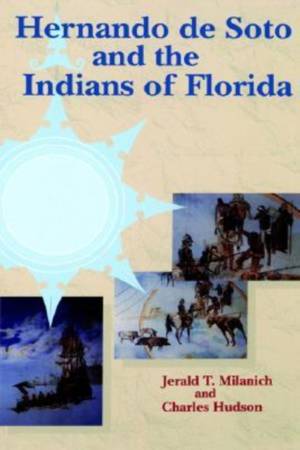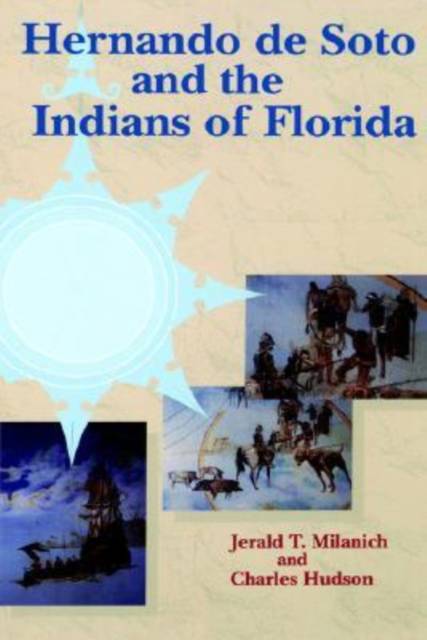
- Retrait gratuit dans votre magasin Club
- 7.000.000 titres dans notre catalogue
- Payer en toute sécurité
- Toujours un magasin près de chez vous
- Retrait gratuit dans votre magasin Club
- 7.000.0000 titres dans notre catalogue
- Payer en toute sécurité
- Toujours un magasin près de chez vous
Description
"An important achievement. Hudson and Milanich have collaborated on determining the route of de Soto in Florida for several years and this book represents their current conclusions. . . . The world became whole five hundred years ago and Florida was at center stage."--Dan F. Morse, University of Arkansas and Arkansas State University
Hernando de Soto, the Spanish conquistador, is legendary in the United States today: counties, cars, caverns, shopping malls, and bridges all bear his name. This work explains the historical importance of his expedition, an incredible journey that began at Tampa Bay in 1539 and ended in Arkansas in 1543.
De Soto's exploration, the first European penetration of eastern North America, preceded a demographic disaster for the aboriginal peoples in the region. Old World diseases, perhaps introduced by the de Soto expedition and certainly by other Europeans in the 16th and 17th centuries, killed many thousands of Indians. By the middle of the 18th century only a few remained alive.
The de Soto narratives provide the first European account of many of these Indian societies as they were at the time of European contact. This work interprets these and other 16th century accounts in the light of new archaeological information, resulting in a more comprehensive view of the native peoples.
Matching de Soto's route and camps to sites where artifacts from the de Soto era have been found, the authors reconstruct his route in Florida and at the same time clarify questions about the social geography and political relationships of the Florida Indians. They link names once known only from documents (e.g., the Uzita, who occupied territory at the de Soto landing site, and the Aguacaleyquen of north peninsular Florida) to actual archaeological remains and sites.
Peering through the mists of centuries, Milanich and Hudson enlarge the picture of native groups of Florida at the point of European contact, allowing historians and anthropologists to conceive of these peoples in a new fashion.
Jerald T. Milanich is curator of archaeology at the Florida Museum of Natural History, Gainesville. He is coeditor of First Encounters: Spanish Exploration in the Caribbean and the United States, 1492-1570 (UPF, 1989) and cocurator of the "First Encounters" exhibit that has traveled to major museums throughout the United States. He is the author or editor of a number of other books, including Florida Archaeology.
Charles Hudson is professor of anthropology at the University of Georgia. He is the author or editor of nine books, including The Southeastern Indians, The Juan Pardo Expeditions, and Four Centuries of Southern Indians. In 1992 he was awarded the James Mooney Award from the Southern Anthropology Society.
Hernando de Soto, the Spanish conquistador, is legendary in the United States today: counties, cars, caverns, shopping malls, and bridges all bear his name. This work explains the historical importance of his expedition, an incredible journey that began at Tampa Bay in 1539 and ended in Arkansas in 1543.
De Soto's exploration, the first European penetration of eastern North America, preceded a demographic disaster for the aboriginal peoples in the region. Old World diseases, perhaps introduced by the de Soto expedition and certainly by other Europeans in the 16th and 17th centuries, killed many thousands of Indians. By the middle of the 18th century only a few remained alive.
The de Soto narratives provide the first European account of many of these Indian societies as they were at the time of European contact. This work interprets these and other 16th century accounts in the light of new archaeological information, resulting in a more comprehensive view of the native peoples.
Matching de Soto's route and camps to sites where artifacts from the de Soto era have been found, the authors reconstruct his route in Florida and at the same time clarify questions about the social geography and political relationships of the Florida Indians. They link names once known only from documents (e.g., the Uzita, who occupied territory at the de Soto landing site, and the Aguacaleyquen of north peninsular Florida) to actual archaeological remains and sites.
Peering through the mists of centuries, Milanich and Hudson enlarge the picture of native groups of Florida at the point of European contact, allowing historians and anthropologists to conceive of these peoples in a new fashion.
Jerald T. Milanich is curator of archaeology at the Florida Museum of Natural History, Gainesville. He is coeditor of First Encounters: Spanish Exploration in the Caribbean and the United States, 1492-1570 (UPF, 1989) and cocurator of the "First Encounters" exhibit that has traveled to major museums throughout the United States. He is the author or editor of a number of other books, including Florida Archaeology.
Charles Hudson is professor of anthropology at the University of Georgia. He is the author or editor of nine books, including The Southeastern Indians, The Juan Pardo Expeditions, and Four Centuries of Southern Indians. In 1992 he was awarded the James Mooney Award from the Southern Anthropology Society.
Spécifications
Parties prenantes
- Auteur(s) :
- Editeur:
Contenu
- Nombre de pages :
- 307
- Langue:
- Anglais
- Collection :
Caractéristiques
- EAN:
- 9780813011707
- Date de parution :
- 20-12-92
- Format:
- Livre relié
- Format numérique:
- Genaaid
- Dimensions :
- 158 mm x 237 mm
- Poids :
- 607 g

Les avis
Nous publions uniquement les avis qui respectent les conditions requises. Consultez nos conditions pour les avis.






